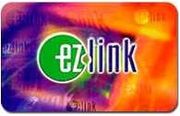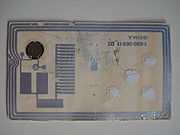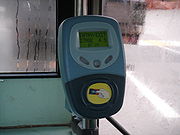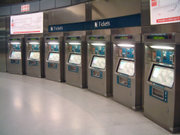
EZ-Link
Encyclopedia





Contactless smart card
A contactless smart card is any pocket-sized card with embedded integrated circuits that can process and store data, and communicate with a terminal via radio waves. There are two broad categories of contactless smart cards. Memory cards contain non-volatile memory storage components, and perhaps...
based on the Sony
Sony
, commonly referred to as Sony, is a Japanese multinational conglomerate corporation headquartered in Minato, Tokyo, Japan and the world's fifth largest media conglomerate measured by revenues....
FeliCa
FeliCa
FeliCa is a contactless RFID smart card system from Sony in Japan, primarily used in electronic money cards. The name stands for Felicity Card...
smartcard technology and used for the payment of public transportation fares in Singapore
Singapore
Singapore , officially the Republic of Singapore, is a Southeast Asian city-state off the southern tip of the Malay Peninsula, north of the equator. An island country made up of 63 islands, it is separated from Malaysia by the Straits of Johor to its north and from Indonesia's Riau Islands by the...
, with limited use in the small payments retail sector. It currently has a monopoly over public transportation fare payments in Singapore until the new NETS
Network for Electronic Transfers
The Network for Electronic Transfers Pte Ltd was founded in 1985 to operate and manage an online debit payment system pioneering Singapore's shift to a cashless society. It has since grown to a multi-service organisation, providing a comprehensive range of electronic payment services...
CashCard, which has a monopoly over Electronic Road Pricing toll payments, enters the market in September 2009 (and vice-versa). Established in 2001, it was promoted as the means for speedier boarding times on bus
Bus
A bus is a road vehicle designed to carry passengers. Buses can have a capacity as high as 300 passengers. The most common type of bus is the single-decker bus, with larger loads carried by double-decker buses and articulated buses, and smaller loads carried by midibuses and minibuses; coaches are...
es. EZ-Link cards are sold, distributed and managed by EZ-Link Pte. Ltd., a subsidiary of Singapore's Land Transport Authority
Land Transport Authority
The Land Transport Authority is a statutory board under the Ministry of Transport of the Singapore Government.-History:...
. , there are over 10 million EZ-Link cards in circulation, with 4 million card-based transactions occurring daily. Effective 1 October 2009, the new CEPAS
CEPAS
CEPAS, or Contactless e-Purse Application, is a Singaporean specification for an electronic money smart card. CEPAS has been deployed islandwide, replacing the previous original EZ-Link card effective 1 October 2009.- Function :...
EZ-Link card has replaced the original EZ-Link card for use islandwide.
Development
The Land Transport AuthorityLand Transport Authority
The Land Transport Authority is a statutory board under the Ministry of Transport of the Singapore Government.-History:...
(LTA) introduced its pilot testing of the card to 100,000 volunteers on 26 February 2000. Initially for commuters who made at least five trips on MRT/LRT per week, the card was branded as the "Super Rider". As an incentive, volunteers were given 10% rebate off their regular fare during the one month period.
Two further tests were made, with the scheme extending to frequent bus users on selected routes, on an invitation basis. The S$
Singapore dollar
The Singapore dollar or Dollar is the official currency of Singapore. It is normally abbreviated with the dollar sign $, or alternatively S$ to distinguish it from other dollar-denominated currencies...
134.6 million contract was awarded to the ERG Motorola Alliance to supply 5 million card and readers.
Uses of the card
The card is commonly used in SingaporeSingapore
Singapore , officially the Republic of Singapore, is a Southeast Asian city-state off the southern tip of the Malay Peninsula, north of the equator. An island country made up of 63 islands, it is separated from Malaysia by the Straits of Johor to its north and from Indonesia's Riau Islands by the...
as a smartcard for paying transportation fees in the city-state
City-state
A city-state is an independent or autonomous entity whose territory consists of a city which is not administered as a part of another local government.-Historical city-states:...
's Mass Rapid Transit
Mass Rapid Transit (Singapore)
The Mass Rapid Transit or MRT is a rapid transit system that forms the backbone of the railway system in Singapore, spanning the entire city-state. The initial section of the MRT, between Yio Chu Kang Station and Toa Payoh Station, opened in 1987 establishing itself as the second-oldest metro...
(MRT), Light Rail Transit (LRT) and public bus services
Bus transport in Singapore
Bus transport in Singapore is the most comprehensive and affordable means of public transport for the masses, with over two million rides taken per day on average on the buses of the two main public transport providers SBS Transit and SMRT Corporation...
. The card also serves as a supplementary identification and concession
Concession
Concession may refer to:* Concession : failure to challenge or cessation of challenging, as in "conceding an election" or "conceding a game".* Concession : a contracted-out service, as in concession stand....
card for students in nationally recognised educational institutes
Education in Singapore
Education in Singapore is managed by the Ministry of Education , which controls the development and administration of state schools receiving government funding, but also has an advisory and supervisory role in respect of private schools...
, full-time national service personnel serving in the Singapore Armed Forces
Singapore Armed Forces
The Singapore Armed Forces is the military arm of the Total Defence of the Republic of Singapore; as well as the military component of the Ministry of Defence. The SAF comprises three branches: the Singapore Army, the Republic of Singapore Air Force and the Republic of Singapore Navy...
, Singapore Civil Defence Force
Singapore Civil Defence Force
The Singapore Civil Defence Force is the main agency in charge of the provision of emergency services in Singapore during peacetime and emergency.A uniformed organisation under the purview of the Ministry of Home Affairs, the main role of SCDF is to provide...
and Singapore Police Force
Singapore Police Force
The Singapore Police Force is the main agency tasked with maintaining law and order in the city-state. Formerly known as the Republic of Singapore Police , it has grown from an 11-man organisation to a 38,587 strong force...
or senior citizen
Senior citizen
Senior citizen is a common polite designation for an elderly person in both UK and US English, and it implies or means that the person is retired. This in turn implies or in fact means that the person is over the retirement age, which varies according to country. Synonyms include pensioner in UK...
s who are over sixty years old.
The system has since been expanded, with EZ-Link cards being used for payments in Singapore branches of McDonald's
McDonald's
McDonald's Corporation is the world's largest chain of hamburger fast food restaurants, serving around 64 million customers daily in 119 countries. Headquartered in the United States, the company began in 1940 as a barbecue restaurant operated by the eponymous Richard and Maurice McDonald; in 1948...
. Some schools in Singapore
Singapore
Singapore , officially the Republic of Singapore, is a Southeast Asian city-state off the southern tip of the Malay Peninsula, north of the equator. An island country made up of 63 islands, it is separated from Malaysia by the Straits of Johor to its north and from Indonesia's Riau Islands by the...
have also started to adopt the EZ-Link card as a way to mark the attendance of students and to pay for food served within the school campus.
A system is similar to the Octopus card
Octopus card
The Octopus card is a rechargeable contactless stored value smart card used to transfer electronic payments in online or offline systems in Hong Kong...
in Hong Kong and Touch 'n Go
Touch 'n Go
The Touch 'n Go or smart card is used by Malaysian toll expressway and highway operators as the sole electronic payment system . The credit card sized smartcard made of plastic with Philips' MIFARE microchip technology embedded in it....
in Malaysia.
On 3 December 2005, EZ-Link Pte Ltd announced that it was working with NETS
Network for Electronic Transfers
The Network for Electronic Transfers Pte Ltd was founded in 1985 to operate and manage an online debit payment system pioneering Singapore's shift to a cashless society. It has since grown to a multi-service organisation, providing a comprehensive range of electronic payment services...
to create a new hybrid card
CEPAS
CEPAS, or Contactless e-Purse Application, is a Singaporean specification for an electronic money smart card. CEPAS has been deployed islandwide, replacing the previous original EZ-Link card effective 1 October 2009.- Function :...
which will have the functions of both the EZ-Link card and the CashCard. This card would make it possible for one card to be used for payment on land transport in Singapore — ERP
Electronic Road Pricing
The Electronic Road Pricing scheme is an electronic toll collection scheme adopted in Singapore to manage traffic by road pricing, and as a usage-based taxation mechanism to complement the purchase-based Certificate of Entitlement system...
, bus, MRT, stalls and library. Work on this card was expected to be completed in 2008, and it is to replace the existing Ez-Link cards in 2009 as the existing EZ-Link cards are being phased-out.
On 17 October 2007, Starhub
StarHub
StarHub Limited is a full-fledged telecommunications company providing a full range of services over mobile, internet and fixed platforms in Singapore...
and EZ-Link Pte Ltd declared the start of a 6-month trial on phones with an embedded EZ-Link card.
System for e-Payments (SeP)
A trial to test the system was held from 29 August to 28 October 2008. The trial, which involved some 5,000 commuters, generated 1.7 million transactions and has confirmed that the system is ready for revenue service. Developed in-house by the LTALand Transport Authority
The Land Transport Authority is a statutory board under the Ministry of Transport of the Singapore Government.-History:...
, SeP is built on the Singapore Standard for Contactless ePurse Application (CEPAS
CEPAS
CEPAS, or Contactless e-Purse Application, is a Singaporean specification for an electronic money smart card. CEPAS has been deployed islandwide, replacing the previous original EZ-Link card effective 1 October 2009.- Function :...
) which allows any smart card that complies with the standard to be used with the system and in a wide variety of payment applications.
With SeP, commuters will be able to use cards issued by any card issuer for transit purposes as long as the card complies with the CEPAS
CEPAS
CEPAS, or Contactless e-Purse Application, is a Singaporean specification for an electronic money smart card. CEPAS has been deployed islandwide, replacing the previous original EZ-Link card effective 1 October 2009.- Function :...
standard and includes the transit application. Commuters can eventually use CEPAS
CEPAS
CEPAS, or Contactless e-Purse Application, is a Singaporean specification for an electronic money smart card. CEPAS has been deployed islandwide, replacing the previous original EZ-Link card effective 1 October 2009.- Function :...
-compliant cards for Electronic Road Pricing (ERP) payments in vehicles fitted with the new generation In-vehicle Unit (IU), Electronic Parking System (EPS) carparks and other electronic payment systems that support the CEPAS standard.
Holders of the current ez-link card will get new CEPAS
CEPAS
CEPAS, or Contactless e-Purse Application, is a Singaporean specification for an electronic money smart card. CEPAS has been deployed islandwide, replacing the previous original EZ-Link card effective 1 October 2009.- Function :...
-compliant cards in a free one-for-one card replacement exercise which will start in January 2009. Details of the exercise will be announced in early January 2009. EZ-Link card holders will have ample time and avenues to replace their cards. EZ-Link started selling new CEPAS-compliant cards from December 2008. The new EZ-Link cards also have a higher storage capacity of S$500.00 instead of the previous S$100.00 limit.
Technical data
The EZ-Link card operates on a radio frequencyRadio frequency
Radio frequency is a rate of oscillation in the range of about 3 kHz to 300 GHz, which corresponds to the frequency of radio waves, and the alternating currents which carry radio signals...
(RF) interface of 13.56 MHz at 212 kbit/s, with the potential for communication speeds in excess of 847 kbit/s. It employs the Manchester bit coding scheme
Manchester code
In telecommunication and data storage, Manchester code is a line code in which the encoding of each data bit has at least one transition and occupies the same time...
for noise tolerance against distance fluctuation between the card and the contactless reader, and implements the Triple DES
Triple DES
In cryptography, Triple DES is the common name for the Triple Data Encryption Algorithm block cipher, which applies the Data Encryption Standard cipher algorithm three times to each data block....
algorithm for security.
Pricing
An Adult EZ-Link card costs S$12, inclusive of a S$5 non-refundable card cost and a S$7 card value.There was a problem with commuters attempting to evade paying the full fare, with the prior magnetic farecard system.
Under the EZ-Link system, when a person taps his card on the entry card reader, the system deducts the maximum fare payable from his bus stop to the end of the bus route. If he taps his card on the exit reader when he disembarks, the system will return an amount based on the remaining bus stages to the end of the bus route. If he fails to tap the card on the exit reader when he disembarks, the entry card reader would have already deducted the maximum fare payable to the end of the bus route.
Initially, this system was not very well received by Singaporean commuters due to numerous glitches resulting in overcharging. However, most of these glitches were rectified by the second year of operation: upgrading of the system software and changing the way fares are deducted. Nowadays, when a commuter taps his/her card on the entry card reader, the screen will display the remaining value in the card. The fare will only be deducted when the card is tapped on the exit reader. To ensure that commuters pay their fares, bus drivers are required to ensure that all commuters tap their EZ-Link cards on the entry reader (this gives off a discernible beep), and as with magnetic farecards, inspector
Inspector
Inspector is both a police rank and an administrative position, both used in a number of contexts. However, it is not an equivalent rank in each police force.- Australia :...
s occasionally come on board buses to check the status of commuters' cards and ensure they have paid their fare. Non-EZ-Link card commuters use cash and receive a proof of purchase
Proof of purchase
Proof of purchase is often required for sales promotions and manufacturer rebates as evidence that the customer purchased the product. When multiple purchases are required to redeem these rewards, it is referred to as a premium incentive or collector mechanic.Traditional proof of purchase systems...
for the particular bus trip.
EZ-Online
EZ-Online is an online service provided by EZ-Link. Commuters are able to view their past transaction records, download discount coupons onto their cards, pay for shopping using the EZ-Link card at selected online merchants, and top up their EZ-Link card online so as long as they own a Sony Felica contactless smart card reader. This is sold at most electronic stores.EZ-Online currently supports more than 51 merchants and is applicable only for purchases not more than SGD$100.
Criticisms
- Some people question the need for a children's concession card to be an identity card as well. Indeed, the loss of the concession card would cause much distress to its owner, because administration charges of up to S$20 would be levied for the replacement of a new personalised EZ-Link card.
- Also, some parents criticised the expansion of the use of EZ-Link cards to school canteens and fast food chains. While the primary use of the EZ-Link card for transport is a necessity, they cannot monitor or control their child's food purchases on the same card.
- There were also criticisms over the need to incorporate a non-refundable S$5 card cost into the price of the card. Questions were raised as to why there was a need to charge people to pay for a medium that is used to pay for public transportation. Other similar contactless smart cards such as the EasyCard in Taipei and Octopus in Hong Kong, do not incorporate a non-refundable card cost element. The earlier magnetic card system employed in Singapore did not have a non-refundable component.
- The Standard Ticket issued for single trips has also been criticized for making passengers using it physically return the card to the General Ticketing Machine, and if they do not do so, forfeit the S$1 deposit which they paid on top of their fare earlier on when they purchased the card. Hong Kong and Taipei, both of which employ a contactless smart system for stored value cards, use magnetic tickets and contactless tokens respectively for single trips, and these are retrieved automatically at the faregate when exiting.
It is not true that the bus fare will only be deducted when the commuter taps his or her card when they are alighting. The problem of overcharging still occurs when the commuter forgets to tap his or her card when they alight from the bus. However, that being said, it is still the commuters' responsibility to ensure they tap their card when they are alighting.
The real problem is often when the card reader fails to activate when the bus reaches the bus stop. Sometimes, it takes more than 5 seconds after the bus has stopped before the card reader is activated. By then, most commuters will have alighted from the bus thinking they are charged the correct fare.

